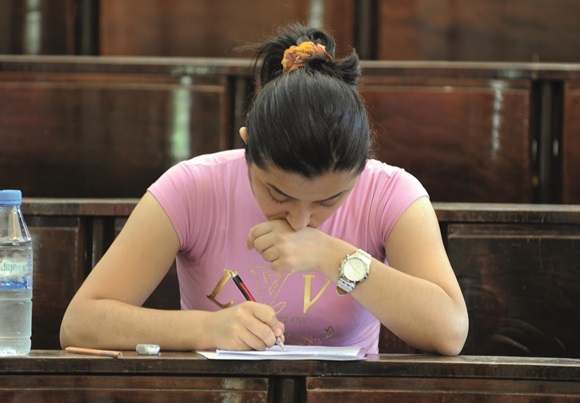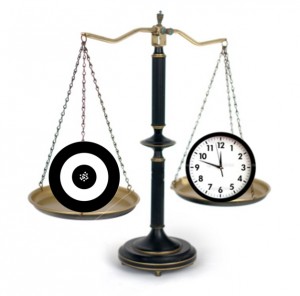How to decide how much time to dedicate to each question in MBA entrance exams?
Anisha and Sagar, who are very good friends, are preparing for different MBA entrance exams. When taking a break from studies, they like to play a game where they are supposed to burst maximum balloons in minimum time but with a limited number of darts. Sagar usually loses this game. He uses all his darts in the given time but is unable to burst more than ten balloons. However, Anisha is an expert at this game. She plays the game with concentration and patience. She takes sufficient time to decide which balloon to target and when. This is the reason her success rate is always higher than Sagar.
Similarly, in the entrance exams, you should know which question to attempt and how much time to devote to each question.
In MBA entrance exams, time versus accuracy is the classic dilemma faced by many students. Students don’t know how much time to devote to any given question. Hence, the students find themselves confused about the number of questions to attempt within the given time-frame to get the best score. This article we will try to shed light on the practical methods and ideas to help you decide the ideal time versus accuracy ratio that you should maintain while attempting any entrance examination.

Preparing for the Common Admission Test (CAT)
CAT is one of the most difficult entrance exams in India for admission to top B-schools. The CAT exam pattern usually changes each year. According to experts, CAT is no longer a speed-based exam. Earlier, the CAT exam had 160-180 questions which were to be attempted within 2 hours. However, now the CAT question paper has 100 questions which are to be attempted within 3 hours. Despite the sectional restrictions, you have more time per question. Hence, when you are focusing on CAT preparations, focus more on accuracy than trying to attempt all questions. We’ll look the approach to reach your personal ideal time versus accuracy ratio in a while.
Praqtical Fact file: CAT 2016 exam structure
| Section | Number of Questions |
| Verbal Ability and Reading Comprehension (VARC) | 34 |
| Data Interpretation and Logical Reasoning (DI & LR) | 32 |
| Quantitative Ability | 34 |
Preparing for other MBA entrance exams
Many top Business Schools conduct their own entrance examinations which have a different format than CAT. Symbiosis Institute of Business Management (SIBM) conducts the SNAP, Xavier’s School of Management (XLRI) conducts the XAT, All India Management Aptitude Testing Service conducts the MAT, All India Council for Technical Education conducts the CMAT. Many of the top management schools across India accept scores of these exams. Exams like SNAP, IIFT, and MAT, have more questions to be solved in a shorter period. Thus, here the focus of the students must be more on speed than accuracy. Whereas, in CAT and CMAT, there are a lesser number of questions to be attempted in a longer period. Hence, here the focus of the student can be on accuracy more than speed.
Praqtical fact file: Number of questions and time in different entrance exams
| Exam | Number of questions | Duration of exam |
| CAT | 100 | 3 hours |
| SNAP | 150 | 2 hours |
| IIFT | 115-135 | 2 hours |
| CMAT | 100 | 3 hours |
| MAT | 200 | 2.5 hours |
The ideal time versus accuracy ratio
Stage 1
Understand the MBA entrance exam for which you are going to appear. For example, if you are taking the CAT, understand the CAT syllabus, the pattern and the type of questions the examination. Every exam is different in the way it tests the student. Some exams test your conceptual clarity, while others test your ability to perform well under time constraints. So, get a clear idea about the exam and its pattern.
Stage 2
Prepare thoroughly and revise the syllabus for before taking the exam. Make sure that you are clear about all the concepts in the syllabus.

Stage 3
Test yourself on a regular basis. Appear for mock tests for all the MBA entrance exams. Solve previous year’s papers. When you are solving previous years’ examination papers, take a note of questions you can attempt in the given period. Then verify the number of correct answers. Analyse the ratio of the number of correct answers versus the number of questions attempted.
For example, in CAT, suppose you attempted 70 questions out of 100 in 3 hours. This means you took, on an average, 2.5 minute per question. However, only 50 answers out the 70 attempted, are right. The ratio of your accuracy versus attempted question would come to 0.7 as opposed to 1 if all questions were correct. Had you attempted only the 50 questions which were right, the time per question would have been 3.6 minutes. With an increment of 1.1 minutes (44%), you can increase the possibility of answering more questions correctly. This would also mean losing lesser marks in negative marking schemes.
Stage 4
Give multiple mock exams and test this ratio to see if there is an improvement in scores.
Praqtical Look
The approach mentioned above is just one way of improving performance in the MBA entrance exams. There might be other better ways too. We cannot generalise the ratio for all. Each person has different strategies for different entrance examinations. By analysing the time taken to attempt each question correctly and by trying to reduce the time while maintaining the accuracy, you can perform great in any entrance examination. Try different approaches, and find the one that works best for you.
What are your thoughts on speed and accuracy? Do you have a strategy worked out? Please share with us in the comments.
—
Image Sources:
